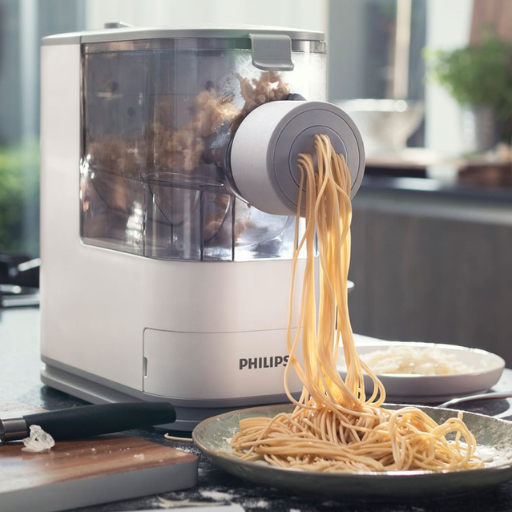In a world where convenience is valued above all else, homemade pasta is still extraordinary. It adds a personal touch to your cooking and ensures your eating is fresh and better than any store-bought option. This article will investigate the best pasta makers of 2023, offering a variety of choices for different skill levels and budgets. Whether you’re an amateur looking to try new things or a seasoned pro hoping to perfect your craft, we have compiled information on some of the most dependable and efficient machines available today. Read on as we discuss these devices’ features, advantages, and disadvantages — everything necessary for you to make an educated decision that results in mouthwatering homemade noodles every time.
How to Choose the Right Pasta Maker for Your Kitchen?
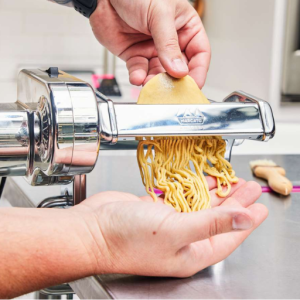
Image source: https://www.eatingwell.com/
Consider a few things to select the best pasta maker for your kitchen. First, judge your cooking ability and frequency of utilization; if you want to make pasta often, it might be worth investing in a good quality machine. Secondly, think about what kind of pasta you want – some machines specialize in specific types, such as lasagna, fettuccine, spaghetti, etcetera. Furthermore, consider how easy the device is to use and clean and any other attachments or features that can enhance your pasta-making experience. Last but not least importantly, keep an eye on your budget because they range from cheap manual ones to expensive electric ones with more advanced functions.
What features should I look for in a pasta machine?
Here are a few essential things to think about when picking out a pasta maker:
- Roller and cutter settings: Be sure to get a machine that has different thickness settings for rolling dough and many different cutters so you can make all sorts of pasta. This is important because it lets you experiment with different styles and textures.
- Ease of use: Look for something user-friendly, like comfortable handles or intuitive systems for feeding dough through. If it’s electric, controls should be easy to understand; if manual, it should feel solidly built and not too hard to work.
- Materials and build quality: Stainless steel is best – it lasts forever and doesn’t wear down quickly. Also, ensure whatever you pick out won’t shake itself apart while making noodles!
- Cleaning and maintenance: It’s nice if parts come off quickly (and are dishwasher safe) or have non-stick coatings – anything that makes cleaning up afterward less painful is good in my book! Trust me, I’ve had some messy encounters with spaghetti rollers before…
- Storage options: Some models have more compact designs or clever ways of storing attachments, which help keep things tidy. These are especially useful if kitchen space is at a premium in your home.
These will ensure that the machine fits into your life seamlessly and helps further any culinary adventures you want!
Manual vs. electric pasta maker: Which is better?
When choosing between a manual or electric pasta maker, your decision will come down to personal preference and how often you make pasta. Manual machines are generally cheaper and smaller and allow for more hands-on involvement in the pasta-making process. This lets you connect with and learn about the craft on a deeper level. They’re also quieter than electric ones and don’t need electricity at all, so they can offer a traditional experience for people who value that.
On the other hand, automatic machines save time and effort by doing everything themselves. They work great, especially when making large amounts of noodles or when someone has trouble operating things manually. They often have many different features or settings so that consistent results can be achieved quickly whenever needed. In short, if you love making pasta as an art form and have lots of free hours during which to do it, then go with a manual machine; however, ease-of-use matters most because time’s always limited — opt for an electric one instead!
Understanding the different types of pasta makers
Examining the different pasta maker types, you usually see three primary groupings: manual, electric, and extruder machines.
- Manual Pasta Makers: These are typical machines that require rolling and cutting pasta by hand. They’re generally cheaper than other options and provide a hands-on experience. Many models are available with this type, which allows for adjusting the thickness of noodles, thereby giving more control over the result.
- Electric Pasta Makers: Electric units are perfect for anyone who wants to save time and effort. These machines automate the mixing and rolling processes involved in making pasta. Most come with adjustable thickness settings so you can create sheets of dough as thin or thick as desired before cutting them into various shapes using one or more attachments provided.
- Extruder Pasta Machines: This machine is designed to produce different forms of spaghetti from dough when pushed through it. An extruder forces pasta dough through shaped dies, thus enabling numerous styles, such as macaroni or spaghetti, among others too long mention here individually. These may be manually operated devices where turning a crank feeds out strands one at once until all has been extruded; alternatively, there exists an electric model allowing batches greater than would otherwise be possible within specific kitchen setups.
Each kind brings its benefits; therefore, consider how often and what you cook before deciding on a specific type.
What Are the Best Pasta Maker Brands in 2023?
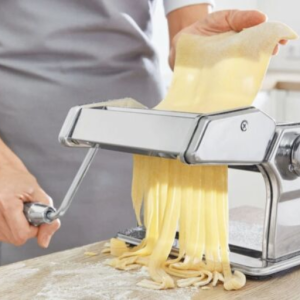
In 2023, many brands stood out as particularly good at making pasta; they did this by being of high quality, performing well, and satisfying their users.
- KitchenAid: This powerful pasta maker can do many different things because it is so versatile. So many people choose the KitchenAid pasta attachment because it works well without taking up too much space on your counter if you already have one of their stand mixers.
- Marcato: The Marcato Atlas is a manual pasta machine that is simple but still very precise, which is why lots of chefs love using it. These models are built to last and have adaptable settings for thickness—perfect for those who like things done the old-fashioned way!
- Breville: When it comes to electrically powered machines, there’s no beating Breville Pasta Makers when it comes to advanced features or simplicity of use. It’s great for mixing and rolling dough easily, too, which is just what you need if convenience tops your priorities list.
- Cuisinart: Cuisinart makes pasta makers that anyone can use easily. They’re designed with beginners and experienced cooks alike in mind- and all at an affordable price point, too! They’re reliable performers, so don’t worry about finding your way around them on those days when things get hectic, either.
- Philips: Philips extruder-type machines are great for trying out different shapes of pasta. They produce quickly and are easy to clean, which means busy home cooks love this brand!
Each brand has unique features and benefits, so consider what you want from a machine before buying one!
Overview of the Marcato Atlas 150
The Marcato Atlas 150 is a well-known hand-operated pasta maker that stands out for its robust structure and user-friendliness. This pasta maker has a stainless steel body, which makes it durable and ensures consistent results at all times. It has ten settings to allow users to make dough of varying thicknesses easily, hence different pasta styles, such as thin lasagne sheets or thick fettuccine. Moreover, the Atlas 150 comes with a manual crank system, which, according to some, provides more control over the process compared to electric models while being compact enough for easy storage and convenience in usage where you can securely clamp it onto any countertop thanks to an included clamp. Therefore, the Marcato Atlas 150 combines conventional workmanship with up-to-date design, which is why many individuals who want authentic homemade pasta prefer this device.
Review of the Imperia pasta maker
Another respected choice is the Imperia pasta maker. It combines practicality and timeless design. Made from substantial stainless steel, this manual machine comes with six different thickness settings, which can be used to make various types of pasta, from tagliatelle to ravioli. Its robust build and ease of use have been highly praised by customers who appreciate the hands-on involvement provided through the hand-crank system and its solid clamp, which ensures secure attachment onto countertops for stable operation during use. Many reviews express delight at being able to produce homemade noodles using this appliance because they say it always gives them restaurant-like quality consistently each time without fail. At the same time, some others may find their interest peaked by its simplicity in assembling parts when new or cleaning after every single use, so simplicity also attracts beginners. Still, experienced cooks love it too, as described by “traditional methods.”
The KitchenAid pasta roller and other attachments
The KitchenAid pasta roller attachment is a multi-purpose tool that can be added to the KitchenAid stand mixer to make fresh pasta. It has adjustable settings for creating different pasta thicknesses to suit various recipes or personal preferences. Besides the pasta roller, KitchenAid has other attachment options, such as cutters for linguine, spaghetti, and fettuccine, as well as specialty shapes like ravioli molds. People love how efficient this system is – it always produces consistent results; they also appreciate its ability to simplify pasta-making without compromising authenticity. What’s more convenient than using your old sound stand mixer with these attachments? No wonder many home cooks consider Kitchen Aid their go-to brand!
How to Make Pasta with a Pasta Maker?
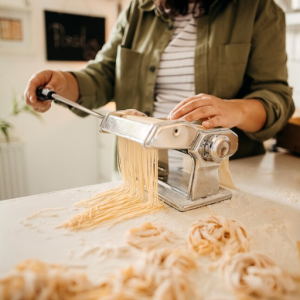
Using a pasta machine to make pasta is an easy and rewarding process. You blend flour with eggs (or water) until it forms a dough. Then, knead the mixture until smooth and wrap it in plastic for half an hour. When it’s rested, divide it into smaller parts so they’re easier to work with. Take one piece at a time, flatten it slightly, and pass it through the pasta maker – adjusting thickness settings as desired. Repeat this step gradually rolling thinner each time until you get to your preferred thickness; cut into shapes such as fettuccine or spaghetti using a cutter attachment; dust cuts with flour so they don’t stick together and cook them in boiling salted water till al dente. Serve alongside any sauce of choice!
The best dough recipe for homemade pasta
To create the perfect pasta dough, you’ll need simple ingredients:
- 2 cups of all-purpose flour
- Three large eggs
- 1/2 teaspoon of salt
- A drizzle of olive oil (optional)
Instructions:
- Create a mound of flour on a clean surface and make a well in the center.
- Add the eggs and salt into the well and mix gradually with a fork, incorporating the flour from the edges.
- Once combined, knead the dough with your hands for 8-10 minutes until it’s smooth and elastic. Add a little more flour if it’s too sticky.
- Wrap the dough in plastic wrap and let it rest for at least 30 minutes at room temperature.
This recipe ensures a supple, flavorful dough that can be easily rolled and shaped into various types of pasta, allowing for an authentic homemade pasta experience.
Step-by-step guide for using a manual pasta maker
- Preparation: Clean the pasta machine and set it up according to the manufacturer’s instructions. Store it somewhere stable.
- Flatten the Dough: Take one portion of your rested dough and press with your hands, or roll it with a rolling pin so it becomes slightly flat, making it easy to fit into the pasta maker.
- Set the Thickness: Start with the widest setting on your pasta maker. Feed the flattened dough through the rollers by turning the handle continuously.
- Adjust the Settings: When you realize that one pass is not enough, fold it into half and put it through again. Continue to reduce thickness each time as you make more passes until you achieve the desired thinness.
- Cut the Pasta: Once you’ve rolled out the dough to your preferred thinness, change to a cutter attachment if available (for spaghetti or fettuccine). Let the dough pass through this cutter, hence shaping it automatically.
- Dust and Store: Sprinkle some flour over freshly cut pasta so that it does not stick together. Either spread it on a clean towel or hang it on a drying rack until ready for cooking.
- Cooking: In case you are now ready to cook your noodles, just boil salted water in a pot, then add pasta; cook until al dente, which takes around 2-4 minutes, depending on how thick they are
This small guide will help you properly use a manual pasta maker, thus having fun making homemade noodles.
The easiest way to make pasta using an electric pasta machine
Making pasta using an electric maker dramatically simplifies the process and provides excellent outcomes. Follow this brief guide:
- Prepare ingredients: Assemble all necessary components, usually flour and eggs. The common ratio is 100 grams per egg.
- Mix dough: Combine flour and eggs until a shaggy mass forms. Transfer onto a floured surface; knead for around 10 minutes until elastic.
- Set up an electric pasta machine: Plug your electric pasta maker into a power outlet, choose the desired thickness settings, and preheat the machine, if needed, according to the manufacturer’s instructions.
- Feed dough: Divide the dough into smaller pieces, flatten it slightly, and feed through the machine, gradually reducing the width settings as the dough becomes smoother.
- Cut and shape pasta: Once you get the required thickness, use the cutter attachment of the machine to create the desired shape of pasta, like fettuccine or lasagna sheets.
- Dust and dry: Dust the cut pasta with flour to prevent sticking; let it dry on a clean towel or pasta drying rack.
- Cook pasta: Boil salted water, then add the prepared noodles. Freshly made ones usually cook within 2-4 minutes, so avoid overcooking them.
This method saves time and effort but still produces incredibly tasty homemade spaghetti that can compete with any hand-rolled traditional variety.
What Accessories Do I Need for My Pasta Maker?
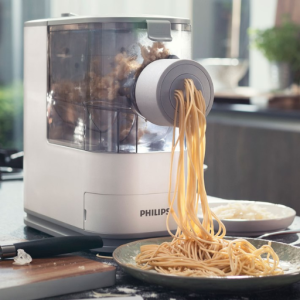
To boost your electric pasta-making experience, below are some add-ons you might need:
- Pasta Blade Attachments: These come in handy when shaping pasta, such as spaghetti, fettuccini, or lasagna.
- Pasta Dryer: This will help air your pasta so it doesn’t stick together and dries uniformly.
- Dough Cutter: It’s perfect for cutting and handling dough without creating a mess.
- Measuring Equipment: If you want to make the best pasta, you need to be precise with your flour and egg measurements. A kitchen scale, together with measuring cups, will ensure uniformity.
- Flour Sprayer: This device ensures that flour is evenly distributed on the pasta, minimizing stickiness during shaping.
- Spatula: This tool can be used to transfer pasta from one place to another without damaging its fragile structure.
When you have all these things at hand, you can make pasta faster while improving the quality of home-cooked meals.
Importance of a pasta roller and cutter
You need to use a pasta roller and cutter to make homemade pasta with the perfect texture and consistency. With a pasta roller, you can ensure that the dough is of even thickness – an essential consideration for cooking and sauce absorption. Evenness also stops it from becoming too chewy or undercooked, yielding fettuccine or ravioli shapes easily when combined with a cutter. More so than improving the quality of your dish by just making better pasta alone, these two tools significantly speed up preparation times, opening doors for beginning cooks (or experienced ones) looking for authentic home-cooked meals.
Why you need a pasta maker attachment for your KitchenAid
If there’s one thing that will change how much time and effort you put into creating fresh noodles at home forevermore, it’s this: KitchenAid Pasta Maker Attachment. This accessory can save an unprecedented amount of both convenience & efficiency while ensuring uniformity in dough thickness, which translates directly into even cooking, among other things. Adjustable settings mean many people find achieving desired textures effortless, but where this shines is with its ability to fit snuggly onto any model mixer produced by KitchenAid, thus transforming said appliance into what amounts practically speaking nothing short of industrial-grade machinery for producing pasta, saving hands-on rolling laboriousness typical elsewhere so much quicker too! The different cutters allow the rapid creation of various consistent shapes, keeping options open all through the making process sparked by culinary curiosity within reach.
Choosing the right pasta and noodle maker for your needs
Should you require selecting and buying a pasta and noodle maker suitable for your kitchen, then it is essential to consider several things. Initially, assess what pasta you want to make and whether an electric or manual appliance is preferable. For example, manual machines are cheaper and smaller; thus, they can be used by those people who do not have enough space in their houses, while electric devices are faster, especially when making large quantities frequently.
Another critical point is checking all features; this means going through different models until finding something with adjustable thickness settings that enable users to attain the desired dough texture without any problem. It should also have various cutter attachments so that many pasta shapes can be made, such as traditional spaghetti or even lasagna and ravioli.
The last but not least factor to consider during the selection process is ease of cleaning/maintenance, together with customer reviews/ratings for reliability purposes (how trustworthy it can be) and user satisfaction levels based on what other individuals say about it. This helps one choose a good pasta machine for their cooking needs, which will also add value to their culinary journey.
Are electric pasta makers Worth the Investment?
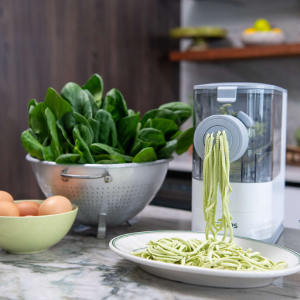
Electric pasta machines can be a good buy for people who make fresh pasta often. They are more convenient and faster than manual models because they do most of the kneading and rolling for you, shaving hours off preparation time. In addition, many electric types have built-in scales, programmable settings, and several cutter attachments that make experimenting with different noodle styles as easy as pie. Although they may cost more initially, the long-run gains in efficiency, uniformity, and ability to produce tasty homemade spaghetti justify their price tags. For those who love cooking or just eating Italian cuisine dishes like lasagna or fettuccine alfredo, having an electric pasta maker at home would not hurt.
Advantages of using an electric pasta maker
- Time-Saving: Dough preparation takes a significantly shorter time with electric pasta makers. Manual machines require a lot of effort for kneading and rolling, while electric ones can do these two very quickly.
- Consistency: Automatic kneading and rolling mechanisms ensure an even thickness of the dough, which may not be achieved when done manually. This makes pasta cook uniformly, thus improving dish quality generally.
- User-Friendly: Most electric pasta makers have easy-to-use interfaces that can be operated by any cook regardless of their level of expertise. Some have programmable settings and built-in scales, among other features that make the process simpler, thereby giving beginners confidence in making pasta.
- Variety: Electric pasta makers usually include several cutter attachments, enabling one to make different shapes and styles, such as angel hair or fettuccine. This versatility allows one to try various recipes from diverse cuisines.
-
Physical Exertion: Using an electric pasta maker eliminates the need for much physical strength required during traditional methods, especially when someone has weak hands or mobility challenges. Therefore, it is suitable for all home cooks.
Top-rated electric pasta machines of 2023
In choosing the best electric pasta makers this year, three stand-out models are those that are known for their performance and customer satisfaction:
- Marcato Atlas Pasta Maker: This machine can do a lot because it has been designed to be solid and long-lasting. This feature allows it to have different levels of thickness and attachments that can be changed for different pasta shapes, making it suitable even for beginners who might not have tried many types of pasta before.
- Philips Pasta Maker HR2357/06: This appliance is unique because of how it was made. It has an energy-efficient engine that takes only 15 minutes to mix dough together. Its powerful motor can also knead and extrude dough. More so, several shaping discs come along with the product, thereby enabling users to create various homemade kinds of pasta. Users may also appreciate components that are easy to clean.
- CucinaPro Pasta Maker Machine: For people who do not want to spend much money but still need something good enough, this one will work perfectly fine; apart from being affordable, it does not lack quality either. In addition, it features many attachments for making different types of pasta plus a durable stainless steel body, according to some reviewers who say they find making traditional dishes fuss-free with these machines.
For numerous years, consumers’ feedback and expert opinions have always ranked these three models highest, which means anyone looking forward to 2023 and improving their cooking skills should consider them during purchase.
Comparing costs: manual vs. electric pasta makers
The cost is a significant factor when choosing between manual and electric pasta makers. If you like hands-on cooking experiences, it would be best to buy an inexpensive manual machine ranging from thirty dollars up to one hundred dollars. It is primarily time-consuming and physically demanding while being affordable, too. That’s why this pasta machine is recommended for people who love working hard with their hands. On the other hand, electric models are priced between one fifty and four hundred dollars due to their convenience of use as well as efficiency achieved through saving time required during preparation stages besides cutting down on manual labor input, thus making them suitable options for frequent cooks or anyone looking forward to streamlining his/her kitchen workflow ultimately. The decision will depend upon various factors such as personal preference, financial capabilities, and frequency of utilization, among others.
Where Can I buy a pasta Maker?
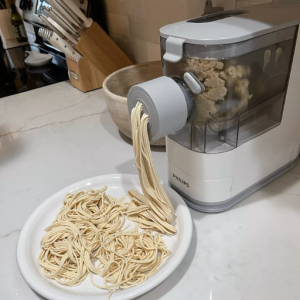
Different places sell pasta makers, including kitchenware stores, big-box retail chains, and online marketplaces. For instance, Amazon, Walmart, and Sur La Table, among others, commonly offer a vast selection of brands and models with their corresponding customer reviews to help you decide what machine to buy. Moreover, specialty kitchen shops may offer hands-on demonstrations and expert advice. At the same time, seasonal sales or discounts from local stores can also be instrumental in finding the best deal.
Best online stores to purchase a pasta maker machine
- Amazon
Amazon is famous for stocking many types of pasta makers, from manual to electric. Compared to other retailers, they are affordable because they offer price cuts aimed at attracting more customers, which explains why most people prefer buying them here.
- Walmart
Pasta machines are sold at Walmart at different prices so that everyone can afford them online or physically go into any store near you since they have both options. The user ratings left by previous buyers, plus special offers found only on their website, make it easier for shoppers looking for cheap but good-quality products.
- Sur La Table
Sur La Table sells expensive, high-performing pasta machines that are considered by many to be top-notch quality cookware items. On their web store, you will find professional-level brands and advice from experts who know how best to use such gadgets during gourmet cooking sessions, creating an immersive experience for food enthusiasts while shopping around for new tools.
Top stores for buying a pasta maker locally
- Bed Bath and Beyond
Bed Bath and Beyond sells kitchen appliances of all types, pasta makers being one such example. Customers who sign up for the Beyond+ program, which gives them access to discounts on their purchases, can find manual or electric models.
- Target
Target sells a wide range of pasta makers in-store and online. With its frequent promotions and user-friendly website, it is a great place for shoppers to compare different brands and prices.
- Kirkland’s
Kirkland’s is mainly known for home goods, but it stocks high-end kitchen products, including pasta-making machines. This means that people who visit the store may find items not sold elsewhere and take advantage of any potential sales happening within their area.
Reading reviews: How to find the best pasta makers of 2023
To discover the best pasta makers in 2023, visit reputable review sites focusing on kitchen appliances. Here are some of the top three sources currently:
- Consumer Reports
This website provides in-depth reviews based on extensive testing and real user input. Consumer reports assess durability, ease of use, and overall performance so you can see how different pasta-making devices compare to each other on the market.
- Good Housekeeping
Good Housekeeping has a team of experts who test kitchen tools, including pasta makers, for functionality and quality. Their reviews often include tips on usage or comparisons between models, which helps shoppers make an informed decision about what will work best in their own homes.
- The Spruce Eats
The Spruce Eats offers detailed articles and reviews about some of the most incredible pasta makers available, plus features they have or might lack, along with pros and cons too; this is great if someone wants to know what a particular model does better than others based on how well it performs among users. -Reading through these portals lets buyers gather information directly from users like them and compare products side by side based on performance alone instead of just going by brand names alone, which may not always represent reality most accurately, especially considering individual needs could differ widely among people when using kitchen utensils.
Frequently Asked Questions (FAQs)
Q: What are the top 7 pasta makers of 2023?
A: The top 7 pasta makers of 2023 include the Marcato Atlas 150 Pasta Machine, Philips 7000 Series Pasta Maker, Imperia Pasta Maker Machine, CucinaPro Pasta Maker, KitchenAid Pasta Roller Attachment, OxGord Pasta Maker, and the Atlas 150 Pasta Machine.
Q: How does the Marcato Atlas 150 Pasta Machine compare to other manual pasta machines?
A: The Marcato Atlas 150 Pasta Machine stands out with its sturdy build, ease of use, and ability to produce a variety of pasta shapes. It offers consistent thickness control and smooth operation compared to other manual pasta machines.
Q: Why should I use a manual pasta machine to make fresh pasta?
A: A manual pasta machine allows better control over the texture and thickness of your pasta. It offers the hands-on experience of pasta making, resulting in fresh pasta with an authentic taste and texture.
Q: What features should I look for in the best manual pasta maker?
A: When looking for the best manual pasta maker, consider ease of use, the ability to cut the pasta into various shapes, durability, and the machine’s maintenance requirements. The ability to produce consistent pasta sheets is also crucial.
Q: How do I use the Philips Pasta Maker to create different pasta shapes?
A: The Philips Pasta Maker has multiple pasta attachments that allow you to create various shapes. Simply change the pasta attachment according to the desired shape and let the machine extrude the pasta dough.
Q: What is the benefit of using an electric pasta maker like the Philips 7000 Series Pasta Maker?
A: Electric pasta makers like the Philips 7000 Series Pasta Maker automate the process of mixing, kneading, and extruding the pasta dough, making it convenient and time-saving for users who want to make fresh pasta without manually rolling and cutting.
Q: Can I make different kinds of pasta with the Imperia Pasta Maker Machine?
A: The Imperia Pasta Maker Machine has various pasta cutters and attachments that allow you to create different kinds of pasta, from thin spaghetti to wider fettuccine and lasagna sheets.
Q: What is the best way to ensure the proper thickness of the pasta when using a manual pasta machine?
A: To ensure the proper thickness of the pasta, start by choosing the appropriate thickness setting on your manual machine. Gradually roll the pasta dough through the machine, reducing the thickness setting with each pass until you reach the desired thickness.
Q: Are there any differences between fresh Pasta and dry pasta when using a pasta maker?
A: Yes, fresh pasta made using a pasta maker is typically softer and more tender than dry pasta. It also cooks faster and has a fresh flavor that dry pasta lacks. Using a pasta maker allows you to enjoy fresh pasta’s authentic taste and texture.
Q: How do I clean my Marcato Atlas 150 Pasta Machine after use?
A: To clean the Marcato Atlas 150 Pasta Machine, allow any leftover pasta dough to dry, then brush it off using a soft brush. Avoid using water as it can damage the machine. Regular maintenance and cleaning ensure your machine stays in top condition.












